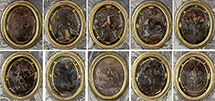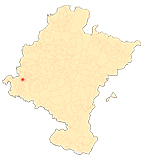Saint Gregory of Ostia
Reliquary medallions from the casket
On the fronts of the box and the upper body of the cover of the chest there are oval rock crystal reliquary medallions painted imitating grisaille enamels, with a window on the front and a gilded silver framework with smooth convex moldings. These pieces are mentioned for the first time in the description of the chest by Pedro de Madrazo y Kuntz in his work Navarre and Logroño, where he confuses them with enamels. They are fourteen medallions in which the Annunciation, Saint Agatha, Saint Mary Magdalene, an unidentified Saint, probably Saint Helen, Saint Sebastian, two Calvaries and two scenes of the Stigmatization of Saint Francis of Assisi are represented. Five pieces have lost their original iconography, being replaced in two of them by modern lithographs with the Rest in the Flight into Egypt and the Exaltation of the Cross. All the medallions have the same outline, with a central scene composed of figures in the foreground, surrounded by a schematic border of ovals and diamonds, with very simple gilded silver clasps. They measure around 6 x cm and were made in Milan in the first decade of the 17th century. The rock crystal plates are meticulously miniaturized on the back, with a technique consisting of painting in reverse, so that the motif is shown in positive on the plate. Since it is painted in reverse, arranging the colors in reverse succession, using pure colors, the order in which they are placed on the support is inverted. First the outline is drawn, then the details, painting in layers, with increasingly larger backgrounds, tracing the background of the scene last. The tones used are gray, both for the clothing and for the flesh tones, and red tones for the backgrounds, complemented by the use of gold, which bring luminosity and richness to the overall composition. The color is used extended in subtle superimposed glazes, in schematic compositions, especially in the figuration of the landscapes in which the figures are inserted, of little realistic character. This technique has been incorrectly called verre eglomisé, which is actually a technique typical of glass work .
BARRAGÁN LANDA, J.J., "Las plagas del campo español y la devoción a San Gregorio Ostiense", in Cuadernos de Etnología y Etnografía en Navarra, n 29, Pamplona, 1978.
CRUZ VALDOVINOS, J.M., "Historia de la platería en la basílica de San Gregorio Ostiense", in Príncipe de Viana, n 163, Pamplona, 1981.
GARCÍA GAINZA, Mª.C. and others, Catalog monumental de Navarra. Merindad de Estella, Volume III**, Pamplona, 1983.
GARCÍA GAINZA, Mª.C., "Arca-relicario de San Gregorio Ostiense de Sorlada", in FERNÁNDEZ GRACIA, R., (Coord.) Pamplona y San Cernín 1611-2011. IV centenary of the city's vow, Pamplona, 2012.
MADRAZO Y KUNTZ, P., Navarra y Logroño, Barcelona, 1886.
MIGUÉLIZ VALCARLOS, I., "Medallones relicarios de origen lombardo en una pieza de orfebrería navarra: el arca relicario de Sorlada", in OADI. Osservatorio per le Arti Decorative in Italia, no. 6, Palermo, 2012.
PASTOR ABAIGAR, V., Fábrica de San Gregorio Ostiense. Basílica y Hospedería, Government of Navarre, Pamplona, 2015.
SALAZAR A. de, Historia de San Gregorio de Piñalva, Obispo de Ostia, Cardenal de la santa Iglesia de Roma, y su bibliotecario y bequest à Latere, Pamplona, 1624.











